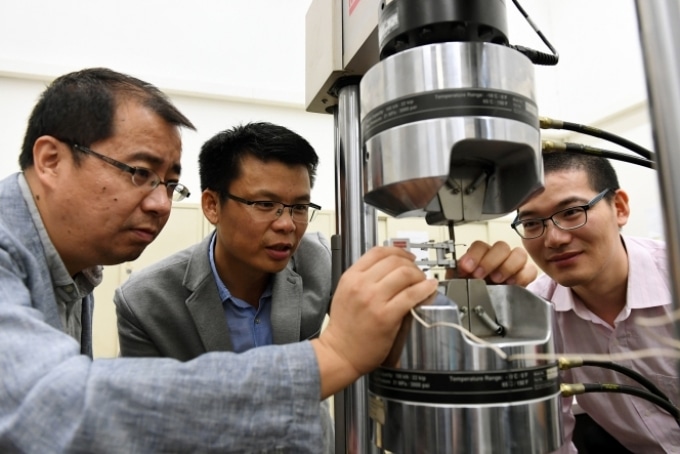Aug 28 2017
Metallic materials with ultra-high strength are required for defense, aerospace and automotive applications. However, in specific high-loading structural applications, it is possible for metallic materials to also have large ductility and high toughness in order to facilitate the precise forming of structural components and to prevent the catastrophic failure of components during service.
Unfortunately, increasing strength frequently leads to the decrease in ductility, which is called the strength-ductility trade-off. For instance, amorphous materials and ceramics have negligible ductility, even though they have ultra-high strength and great hardness. It is technologically and scientifically important to simultaneously increase both ductility and strength of metallic materials using conventional industrial processing routes, however, it is still quite challenging in both the industry sectors and the materials science community.
 The research team uses a tensile machine to test the yield strength and elongation of steel. (From right): Dr He Binbin, Dr Huang Mingxin and Dr Luo Haiwen.
The research team uses a tensile machine to test the yield strength and elongation of steel. (From right): Dr He Binbin, Dr Huang Mingxin and Dr Luo Haiwen.
Recently, a Hong Kong-Beijing-Taiwan mechanical engineering team headed by Dr Huang Mingxin from the University of Hong Kong (HKU) developed a Super Steel, also known as D&P Steel as it adopted a new deformed and partitioned (D&P) strategy) capable of addressing the strength-ductility trade-off. Its material cost is only one-fifth of that of the steel employed in the current defense and aerospace applications. This innovative research has been published in the recent edition of the renowned academic journal Science.
Steels are considered to be most extensively used metallic materials in the history of mankind and are capable of being produced with much greater efficiency than any other metallic materials. Thus, the aspect of developing a ductile and strong breakthrough steel has been a long mission since the commencement of Iron Age in mankind history. It is specifically hard to further enhance the ductility of metallic materials when their yield strength is more than 2 GPa. Strikingly, the Super Steel, (a breakthrough steel), -- which has been manufactured by -- which has been developed by an HKU-led HK-Beijing-Taiwan team and published in the esteemed academic journal Science recently, is considered to be a successful attempt in understanding the above dream of attaining a high ductility more than the yield strength of 2 GPa.
Besides the substantial improvement of tensile properties, this innovative steel has managed to attain the extraordinary yield strength of 2.2 GPa and uniform elongation of 16%. This breakthrough is also known to have two advantages:
(1) Low raw-materials cost
The raw materials cost of the D&P steel is just 20% of the maraging steel employed in defense and aerospace applications. This breakthrough steel’s chemical composition belongs to the system of medium manganese (Mn) steel, comprising of 0.7% vanadium (mass percent), 2% aluminum, 0.47% carbon, 10% manganese, and the balance is iron. Expensive alloying elements have not been used exhaustively but only some common alloying compositions that can be extensively seen in the commercialized steels.
(2) Simple industrial processing
The second advantage refers to the possibility of developing breakthrough steel by using standard industrial processing routes, including annealing, cold rolling and warm rolling. This is considered to be different from the development of various other metallic materials where the fabrication processes involve difficult routes and special equipment, which are hard to scale-up. Thus, it has been anticipated that the present breakthrough steel has a major potential for industrial mass production.
The D&P steel demonstrated much greater yield strength but maintained a much better ductility (uniform elongation) when compared with the extensively used automotive steels and also with the steel used in defense and aerospace. The D&P steel also overtook the nanotwinned (NT) steel which was also produced by the same HKU research team headed by Dr. Huang Mingxin in 2015. Additionally, the developed D&P steel established the best combination of yield strength and uniform elongation together with other existing high-strength metallic materials. The uniform elongation of the developed D&P steel is chiefly much greater than that of metallic materials with yield strength beyond 2.0 GPa.
The development of this breakthrough steel is considered to be a successful example of teamwork amongst young scientists from Hong Kong, Beijing and Taiwan. This partnership is headed by Dr Huang Mingxin’s group from the Department of Mechanical Engineering of the University of Hong Kong (HKU). Dr Huang Mingxin’s group focuses on studying the deformation mechanism of ultra-high strength metallic materials. In this research, Huang’s group initially suggested a new deformation mechanism that the high dislocation density can enhance both ductility and strength simultaneously. It should be noted that a common belief in textbooks is that increasing dislocation density will increase he strength but unfortunately deteriorate the ductility. Dr Luo Haiwen’s group from University of Science and Technology Beijing specializes in steel processing and has successfully launched high mobile dislocation density in this breakthrough steel. This new deformation mechanism was supported by Dr Yen Hung-wei’s group from National Taiwan University by executing the advanced microstructure characterization.
The research result is a collective contribution from young scientists in the University of Hong Kong, University of Science and Technology Beijing, National Taiwan University and City University of Hong Kong and it was published in the esteemed journal Science on 24 August 2017 with a title of “High dislocation density induced large ductility in deformed and partitioned steels”. Dr He Binbin, currently a post-doctoral fellow in Dr Huang’s group, is the first author of this paper. The corresponding authors are Dr Huang Mingxin from the University of Hong Kong and Dr Luo Haiwen from University of Science and Technology Beijing. The complete author list is as below: B.B. He, B. Hu, H.W. Yen, G.J. Cheng, Z.K. Wang, H.W. Luo, M.X. Huang.